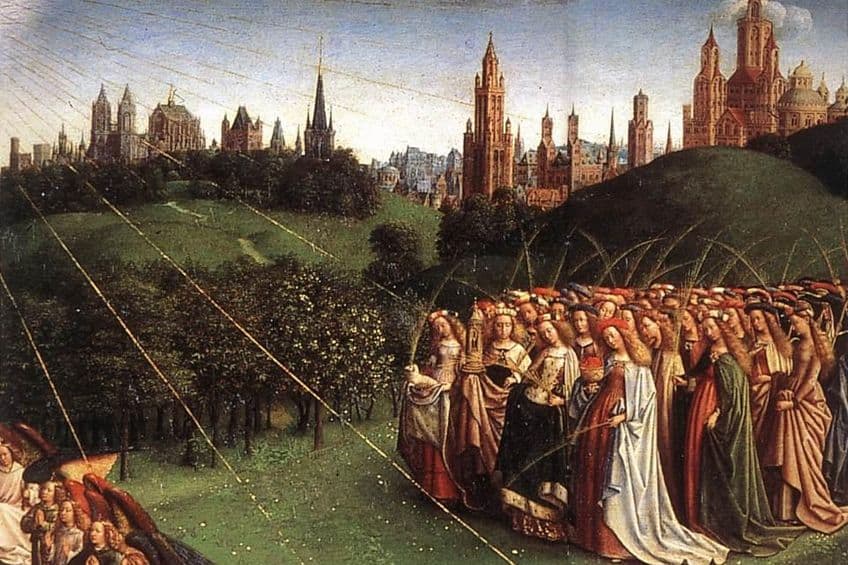Northern Renaissance – The Style of North Renaissance Painting
When did the Northern Renaissance start and what was the difference between Italian Renaissance vs. Northern Renaissance art? The Northern Renaissance time period started in approximately 1430 when artists from the North, most notably Jan van Eyck, began to incorporate the techniques used by Italian Renaissance artists, such as realism and linear perspective. The most significant difference between the Northern Renaissance vs. the Italian Renaissance is that the former wanted to change society based on the principles of the Christian religion, whereas the latter was interested in expressing the desires of the individual. In the North, Renaissance principles were incorporated into many creative fields, such as Northern Renaissance painting and Northern Renaissance architecture.
Contents
Understanding Northern Renaissance Art
Usually, when people think of the Renaissance period, it is Italian artists such as Da Vinci and Michelangelo that first come to mind. Yet, the principles of the Renaissance stretched far beyond the borders of Italy and into Northern territories such as Switzerland, Germany, and Austria, where they were readily adopted by the Northern Renaissance artists. In the North, Renaissance artists had also rejected the aesthetics and ideals of the Medieval period, as their counterparts had done in Italy. The Northern Renaissance time period was one of returning to the ideals of Classical antiquity, which is evident in everything from Northern Renaissance architecture to Northern Renaissance paintings and sculptures. This change in outlook would help steer Europe out of the Dark Ages.

Northern Renaissance vs. Italian Renaissance
The phrase “rebirth” was coined by Italian artist Giorgio Vasari to represent the Italian Renaissance. After the more conservative Gothic era, he regarded the age as a resurgence of ancient Greco-Roman aesthetics and aspirations. The subject matter, style, and aesthetic sensibility of the works of the Italian Renaissance vs. Northern Renaissance were significantly different. With their frescoes, paintings, and sculptures, Italian artists prioritized ultimate beauty, and the overall impression was one of classical harmonization and idealized form. Northern European artists, on the other hand, valued realism. They developed the oil paint medium and produced panel paintings and altarpieces for chapels and churches that expressed the Protestant Reformation’s more solemn sensibilities. Portraits focused primarily on a realistic depiction of the subject, with great detail, accurately examined, that would include its darker psychological qualities, rather than on beauty.
Northern Renaissance artists built on the legacy of manuscript illumination and woodblock printing instead of Greco-Roman art.
The History of Northern Renaissance Art
The Dark Age of Europe was finally coming to an end by the early 15th century. During this period, much European art was still religious in subject matter and, while typically represented in expressive detail, had little emphasis on perspective or realism. By the year 1400, however, Italian artists started referencing Classical sculpture in their artwork. These concepts would spread throughout the continent 50 years later, due to the advent of the printing press, leading artists from the North to embrace a similar approach to artistic depiction.
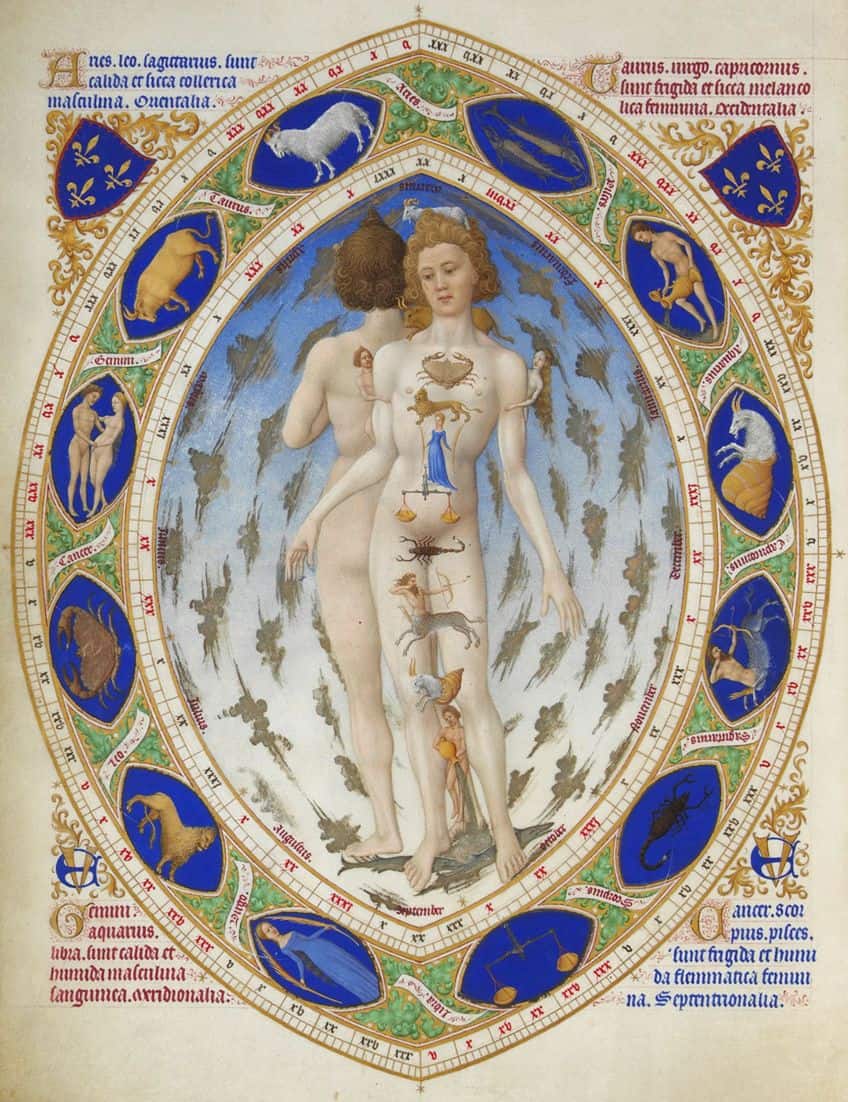
The Early Influence of Illuminated Manuscripts
Manuscript illumination produced in the International Gothic style represented a longstanding tradition. During the medieval era, most books were rare manuscripts created by hand on vellum sheets with vividly inked pictures accented with silver and gold, which gave the impression of being “illuminated”. These manuscripts, created by monks, were predominantly religious in nature, such as prayer books and Bibles.
Bestiaries based on classical Greek and Biblical descriptions of fantastical beasts were incorporated in later volumes.
Paul, Herman, and Johan Limbourg, the Dutch miniaturist brothers who became famous for their illuminated book of prayers to be recited throughout the canonical hours, epitomized the International Gothic style. It was one of the first illuminated manuscripts created by well-known artists instead of monks. The collection of 130 images was dominated by scenes of daily life, half of which were miniatures representing scenes of agricultural activity, court life, and military explorations in jewel-like hues. The Très riches heures du Duc de Berry (c. 1412 – 1416) manuscript is regarded as their most significant work.
The Early Influence of Robert Campin
Robert Campin, inspired by the work of the Limbourgs, became the first renowned master of Flemish art. He was a pioneer in the adoption of oil painting, which defined Northern Renaissance art. Just a few Northern Renaissance paintings can be definitively attributed to Campin because he rarely signed his works, which was typical in the Middle Ages. He typically portrayed religious subjects, as did other International Gothic painters, but his contemporaneous settings representing everyday activities, which were both realistic in observation and allegorical in meaning, launched the Renaissance style. Rogier van der Weyden, a well-known painter, began his training at Campin’s workshop. His Mérode Altarpiece (1427) is regarded by many as his masterwork.
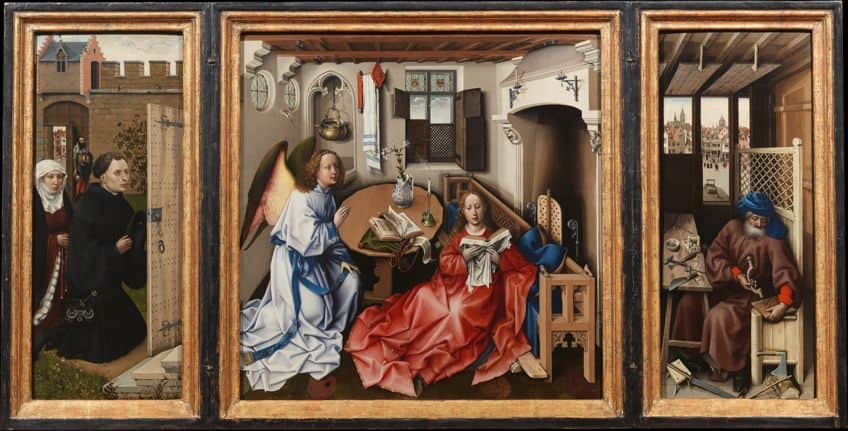
Jan van Eyck Launches Northern Renaissance Art
Jan van Eyck perfected the skill of oil painting to the point where Giorgio Vasari mistakenly credited him with the medium’s creation. Van Eyck’s education and creative background are undocumented, as he first appeared in documents in 1422 as an artist for the ruler of Holland at that time, John III the Pitiless. What is known is that Van Eyck was fluent in Latin and Greek, a sign of a well-educated person. He later became Philip Duke of Burgundy’s court artist until around 1429. With its application of oil painting and realism, his groundbreaking work The Ghent Altarpiece (1431) initiated the Northern Renaissance.
His method and style inspired Hans Memling, Petrus Christus, and van der Weyden, among others. He was the only Northern European painter of the 15th century to sign his artwork.
The Impact of the Printing Press
The printing press, created in 1450 by Johann Gutenberg, popularized the image of artists as enlightened geniuses. For the very first time, religious books were available to all literate people, and philosophers and artists were capable of publishing their own literature and artworks. Printing had a transformative influence on the age, notably in Northern Europe. The first German edition of Gutenberg’s Bible (1455), made the holy book easily accessible, and although published in Latin, German, and English translations followed in the 1520s.

The text’s unprecedented accessibility coincided with the growing Protestant notion that an individual might have personal contact with the Almighty without the necessity for an intermediary priest. Many of the early publications were religious works, and quite a few of them were illustrated, prompting a multitude of Northern Renaissance artists to specialize in printmaking for a wider audience. Artists started making individual prints and sets of prints for the marketplace, resulting in freedom of style and subject matter.
The Influence of Albrecht Dürer
In approximately 1500, awareness of the Italian Renaissance started to have an influence on Northern art, especially through the renowned engraver, printmaker, draftsman, and painter Albrecht Dürer. His works started to demonstrate a significant connection with the intellectual and creative trends of Renaissance Italy and Venice after a trip to Italy. He was highly affected by Venetian color and had a deep interest in Humanist ideology, which led to a lifelong association with Conrad Celtis, the German Humanist. He also interacted with prominent Italian artists like Raphael.
Underweysung der Messung (1525) and Four Books of Human Proportion (1532) by Dürer were the very first such creations by a Northern European artist that featured a scientific treatment of perspective.
Merchant Class Patronage
Whereas in the Italian Renaissance, a few affluent patrons, such as Florence’s governing Medici family commissioned the majority of the age’s masterpieces, the Northern Renaissance predominantly produced artworks for a thriving merchant class. Portraiture, panel paintings, prints, and even small altarpieces, all of which could be featured in private residences, were in high demand as towns like Antwerp became economic hubs. While some painters served royal clients for a period, such as van Eyck’s association with the Duke of Burgundy or Dürer’s efforts for Frederick III of Saxony, they also earned a large part of their earnings from private patrons and a considerably larger public audience than that of the Italian painters.
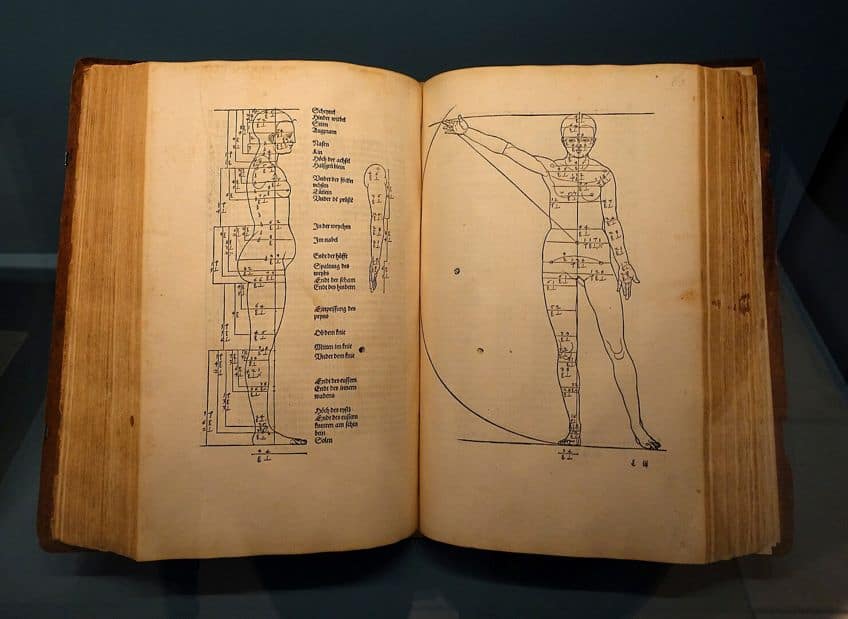
The Impact of the Protestant Reformation
The tone of Northern European painting reflected the cultural and social ideals of that period, whether portraying modest living as Pieter Bruegel the Elder did or depicting Christ’s suffering as Matthias Grünewald did. Martin Luther published his Ninety-five Theses in 1517, criticizing the pomp and hypocrisy of the Roman Catholic Church and sparking the German Protestant Reformation. The Low Countries, namely the Netherlands, Belgium, and Luxembourg, were ruled by Spain’s Catholic Hapsburg monarchy and gripped by religious clashes, persecution, and iconoclasm’s obliteration of many remarkable, idealistic religious works of art. Artists tried to negotiate the dangers of the turbulent age with different tactics.
Early artists, such as Dürer and van Eyck, utilized elaborate iconography and cryptic symbolism that could be interpreted in various ways depending on the religious context.
Other artists, such as Hans Holbein the Younger, emigrated. In his situation, he relocated to England to serve as the court portraitist to Henry VIII. Cranach the Elder collaborated closely with Reformation movements, shifting his focus from mythical subjects to the more religious subject matter and moral parodies of contemporary society. His work, which underscored the weaknesses and imperfections of human nature, was well-received by both the Protestant populace and the movement’s main theorists.
Notable Northern Renaissance Paintings
Art representing religious characters or situations followed Protestant theology by representing individuals and stories without idolization, resulting in a more naturalistic approach. With the transition away from idealized works, Northern Renaissance artists created a new era of genre paintings that focused on everyday situations and themes while taking a more moralistic approach to contemporary life. Landscapes, portraiture, animal depictions, still-lifes, biblical tales, agricultural labor, and everyday life artworks were all represented in this era.
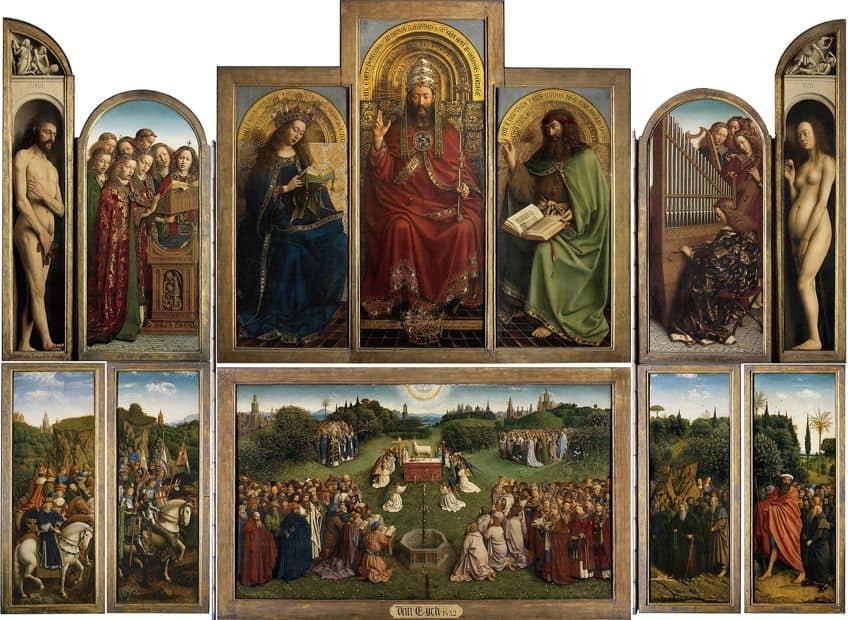
Ghent Altarpiece (1431) by Jan van Eyck
| Artist | Jan van Eyck (1380 – 1441) |
| Date Completed | 1431 |
| Medium | Grisaille and oil on wood |
| Dimensions (cm) | 461 x 350 |
| Location | Saint Bavo Cathedral, Ghent, Belgium |
When the altarpiece was first presented, it was lauded not just as a masterwork, but also as a one-of-a-kind piece that embodied the essence and ingenuity of Northern European art. Because of this, the art has been looted and retrieved several times. The panel on the lower left is a later duplicate, meant to replicate the missing original, which is still being investigated decades later. While all of the religious imagery was heavily influenced by tradition, it was remarkably innovative for its period due to van Eyck’s masterful utilization of oil paint and realism, which can be observed in every little detail, even down to the pearls adorning Mary’s dress, every one of them a droplet of gray with a solitary speck of white paint on it to produce an iridescent shine.
Musical academics have been able to discern the notes every angel is singing by the shape of their lips, demonstrating Van Eyck’s excellent observational abilities.

The Descent from the Cross (c. 1443) by Rogier van der Weyden
| Artist | Rogier van der Weyden (1400 – 1464) |
| Date Completed | c. 1443 |
| Medium | Oil on oak panel |
| Dimensions (cm) | 220 x 262 |
| Location | Museo del Prado, Madrid, Spain |
Three men carry Jesus down from the crucifixion in this dramatic religious artwork. The incredibly condensed and compacted image is packed with movement, fueled by characters charged with passion. Pain and anguish can be seen on every face. The artwork also combines layers of symbolic significance, such as the skull at St. John’s feet alluding to the Mount of Golgotha and Mary Magdalene’s red dress with her exposed neckline alluding to a fallen woman. The man on the ladder’s blue damask and high position implies an angelic presence. Two miniature crossbows in the top left and left corners represent the Great Crossbowmen’s Guild, which commissioned this piece. Van Weyden used anatomical realism to achieve an emotional effect as well as a realistic spatial illusion. He extended the Virgin’s left leg, allowing her mantle to envelop the base of the crucifix and the ladder.
To express the emotional afflictions of the tragic incident, he deformed parts of the figures, as evident in Magdalene’s arm and the head of Christ’s horizontal axis.
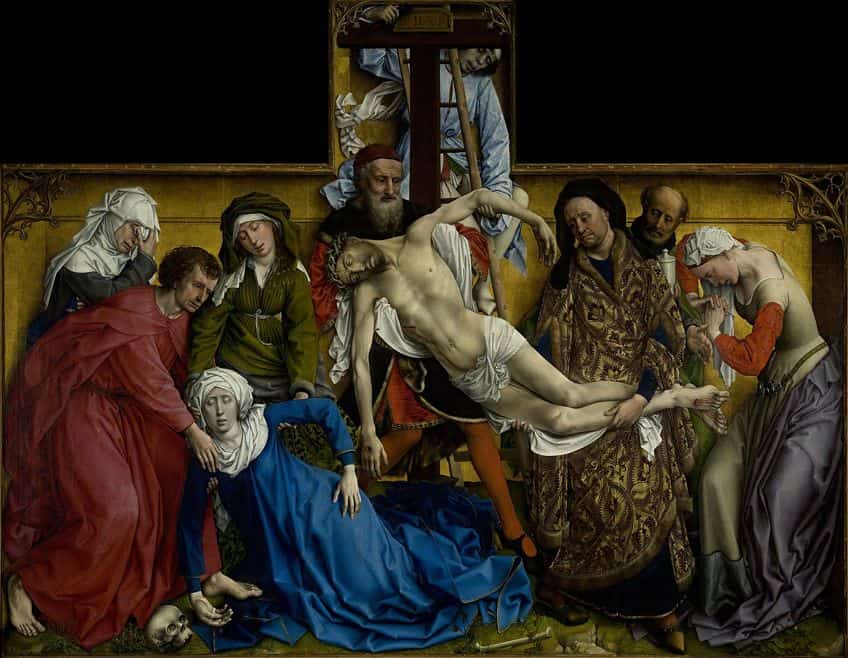
Self-Portrait (1500) by Albrecht Dürer
| Artist | Albrecht Dürer (1471 – 1528) |
| Date Completed | 1500 |
| Medium | Oil on panel |
| Dimensions (cm) | 66 x 49 |
| Location | Alte Pinakothek, Munich, Germany |
Dürer made three self-portraits, the last of which is the most sophisticated. Among the artist’s achievements was the use of a frontal posture for a conventional portrait for the first time, as well as a unique self-portrait. Because the artwork is so vertically symmetrical, the slightly off-center head with eyes gazing to the left generates a sensation of movement. The dark and rich browns of his coat, the illuminated long locks of his hair, and the plush fur collar contrast with his fair complexion and the dark background creating a somber mood.

This self-portrait would have largely reminded the audience of his day of conventional portrayals of Christ. The unusually dark backdrop, with inscriptions floating on each side of him, gives the impression of loaded symbolism and shows him as inhabiting a realm undefined by location or time. This creates a sense of monumentality. Moreover, despite the overall appearance of classical discipline, the piece has a contemporary feel to it Ingres-style classicism. The countenance is rigid and emotionless, like a mask, concealing the restless turbulence of anguish and desire beneath.
The Northern Renaissance style may be regarded as the unique outcome of a mix of Late Gothic art, contemporaneous observational concepts, and Reformation philosophy. During the period, the European mentality in the North perceived their God in every part of the universe, hence the world was portrayed with a rigorous realism that bordered on the spiritual. Although sculptures were produced during the Northern Renaissance time period, they are not included in this article as sculptures in the Northern Renaissance vs. Italian Renaissance are not typically regarded as technically transformative.
Frequently Asked Questions
When Did the Northern Renaissance Start?
There were several influences that served to influence the formative years of the period, such as illuminated manuscripts. However, the period is noted as having begun with the works of Jan van Eyck around 1430. This is when Van Eyck and other artists from the North began to incorporate the realism and linear perspective that was apparent in the works of their counterparts in the South. However, despite being influenced by the Italian Renaissance, the works produced in the North differed greatly in style and subject matter.
What Is the Actual Difference Between Northern Renaissance vs. Italian Renaissance Art?
There were several notable differences between the Renaissances occurring in the North and South. The Northern Renaissance artists were more focused on life-like portrayals of religious subjects, and the Southern artists were beginning to explore matters of personal interest. Northern realism differed from the South’s search for a perfect and idealized sense of beauty. The Northern Renaissance artists were also renowned for their innovations with oil paint as a medium. Whereas the South was more influenced by Greco-Roman art, their Northern counterparts were inspired by printing advancements and illuminated manuscripts.
Liam Davis is an experienced art historian with demonstrated experience in the industry. After graduating from the Academy of Art History with a bachelor’s degree, Liam worked for many years as a copywriter for various art magazines and online art galleries. He also worked as an art curator for an art gallery in Illinois before working now as editor-in-chief for artfilemagazine.com. Liam’s passion is, aside from sculptures from the Roman and Greek periods, cave paintings, and neolithic art.
Learn more about Liam Davis and about us.
Cite this Article
Liam, Davis, “Northern Renaissance – The Style of North Renaissance Painting.” artfilemagazine – Your Online Art Source. May 16, 2023. URL: https://artfilemagazine.com/northern-renaissance/
Davis, L. (2023, 16 May). Northern Renaissance – The Style of North Renaissance Painting. artfilemagazine – Your Online Art Source. https://artfilemagazine.com/northern-renaissance/
Davis, Liam. “Northern Renaissance – The Style of North Renaissance Painting.” artfilemagazine – Your Online Art Source, May 16, 2023. https://artfilemagazine.com/northern-renaissance/.


